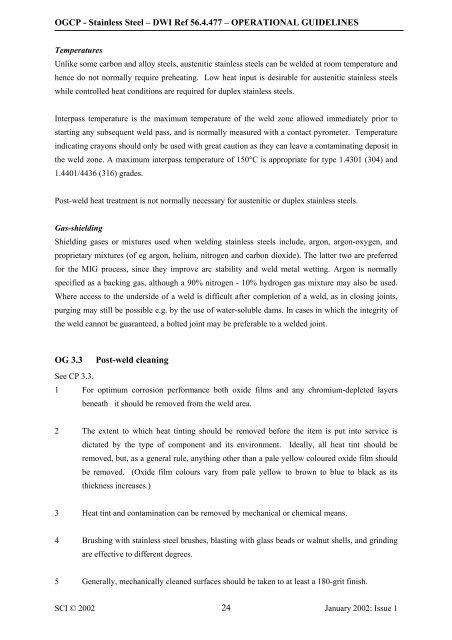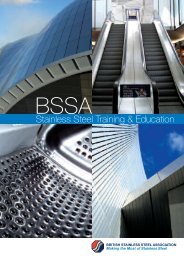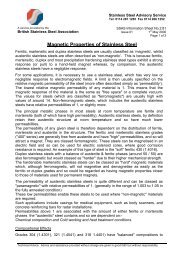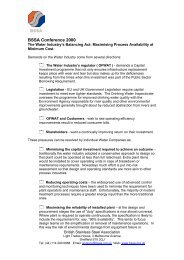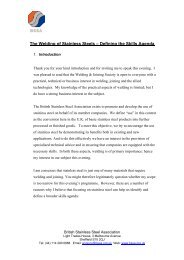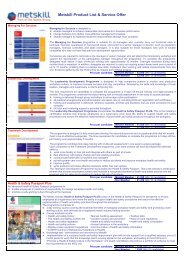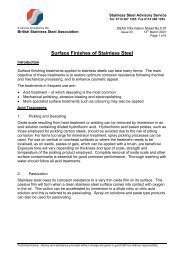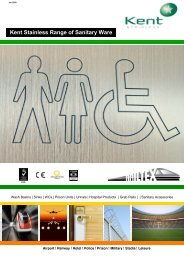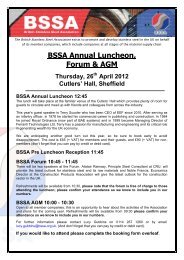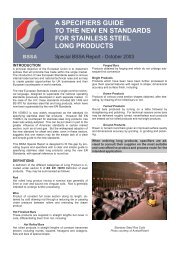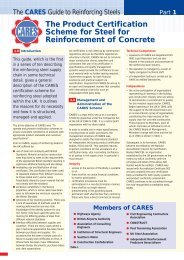Operational guidelines and code of practice for stainless steel
Operational guidelines and code of practice for stainless steel
Operational guidelines and code of practice for stainless steel
Create successful ePaper yourself
Turn your PDF publications into a flip-book with our unique Google optimized e-Paper software.
OGCP - Stainless Steel – DWI Ref 56.4.477 – OPERATIONAL GUIDELINES<br />
Temperatures<br />
Unlike some carbon <strong>and</strong> alloy <strong>steel</strong>s, austenitic <strong>stainless</strong> <strong>steel</strong>s can be welded at room temperature <strong>and</strong><br />
hence do not normally require preheating. Low heat input is desirable <strong>for</strong> austenitic <strong>stainless</strong> <strong>steel</strong>s<br />
while controlled heat conditions are required <strong>for</strong> duplex <strong>stainless</strong> <strong>steel</strong>s.<br />
Interpass temperature is the maximum temperature <strong>of</strong> the weld zone allowed immediately prior to<br />
starting any subsequent weld pass, <strong>and</strong> is normally measured with a contact pyrometer. Temperature<br />
indicating crayons should only be used with great caution as they can leave a contaminating deposit in<br />
the weld zone. A maximum interpass temperature <strong>of</strong> 150°C is appropriate <strong>for</strong> type 1.4301 (304) <strong>and</strong><br />
1.4401/4436 (316) grades.<br />
Post-weld heat treatment is not normally necessary <strong>for</strong> austenitic or duplex <strong>stainless</strong> <strong>steel</strong>s.<br />
Gas-shielding<br />
Shielding gases or mixtures used when welding <strong>stainless</strong> <strong>steel</strong>s include, argon, argon-oxygen, <strong>and</strong><br />
proprietary mixtures (<strong>of</strong> eg argon, helium, nitrogen <strong>and</strong> carbon dioxide). The latter two are preferred<br />
<strong>for</strong> the MIG process, since they improve arc stability <strong>and</strong> weld metal wetting. Argon is normally<br />
specified as a backing gas, although a 90% nitrogen - 10% hydrogen gas mixture may also be used.<br />
Where access to the underside <strong>of</strong> a weld is difficult after completion <strong>of</strong> a weld, as in closing joints,<br />
purging may still be possible e.g. by the use <strong>of</strong> water-soluble dams. In cases in which the integrity <strong>of</strong><br />
the weld cannot be guaranteed, a bolted joint may be preferable to a welded joint.<br />
OG 3.3 Post-weld cleaning<br />
See CP 3.3.<br />
1 For optimum corrosion per<strong>for</strong>mance both oxide films <strong>and</strong> any chromium-depleted layers<br />
beneath it should be removed from the weld area.<br />
2 The extent to which heat tinting should be removed be<strong>for</strong>e the item is put into service is<br />
dictated by the type <strong>of</strong> component <strong>and</strong> its environment. Ideally, all heat tint should be<br />
removed, but, as a general rule, anything other than a pale yellow coloured oxide film should<br />
be removed. (Oxide film colours vary from pale yellow to brown to blue to black as its<br />
thickness increases.)<br />
3 Heat tint <strong>and</strong> contamination can be removed by mechanical or chemical means.<br />
4 Brushing with <strong>stainless</strong> <strong>steel</strong> brushes, blasting with glass beads or walnut shells, <strong>and</strong> grinding<br />
are effective to different degrees.<br />
5 Generally, mechanically cleaned surfaces should be taken to at least a 180-grit finish.<br />
SCI © 2002 24<br />
January 2002: Issue 1


